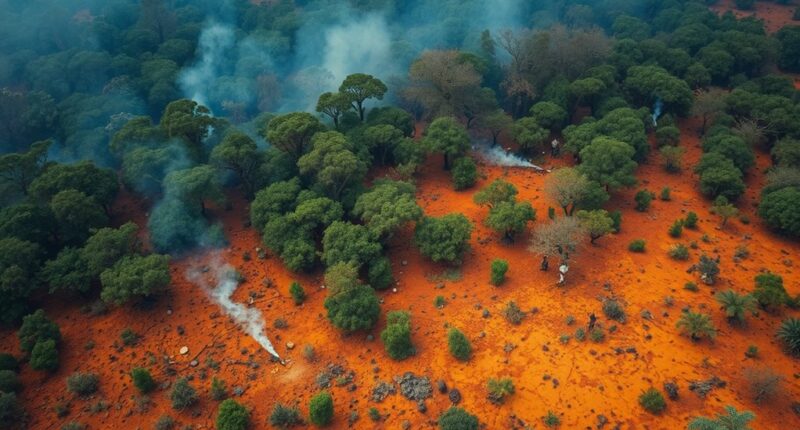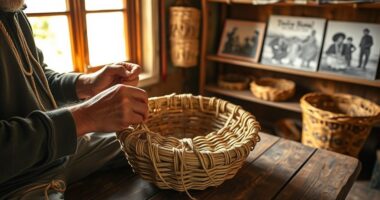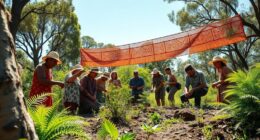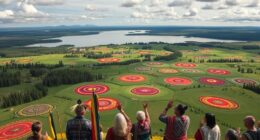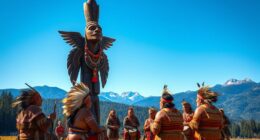Traditional fire-stick farming is an Indigenous land management method where you use carefully controlled burns to manage ecosystems. This practice helps clear excess vegetation, reduce wildfire risks, and promote new plant growth while supporting local wildlife and cultural traditions. Indigenous communities have passed down this ecological knowledge for generations, blending science with tradition. This approach fosters healthier, more resilient landscapes. If you keep exploring, you’ll discover how these ancient practices can still benefit modern land stewardship today.
Key Takeaways
- Traditional fire-stick farming involves controlled burns to clear vegetation and promote ecosystem health, practiced by Indigenous communities.
- It relies on Indigenous ecological knowledge to determine optimal timing, location, and methods of prescribed burns.
- Benefits include reducing wildfire risks, supporting biodiversity, and fostering nutrient-rich plant growth.
- Modern fire policies often ignore Indigenous practices, leading to ecological imbalance and increased wildfire severity.
- Indigenous communities advocate for integrating traditional fire management with scientific approaches to enhance ecological and cultural outcomes.
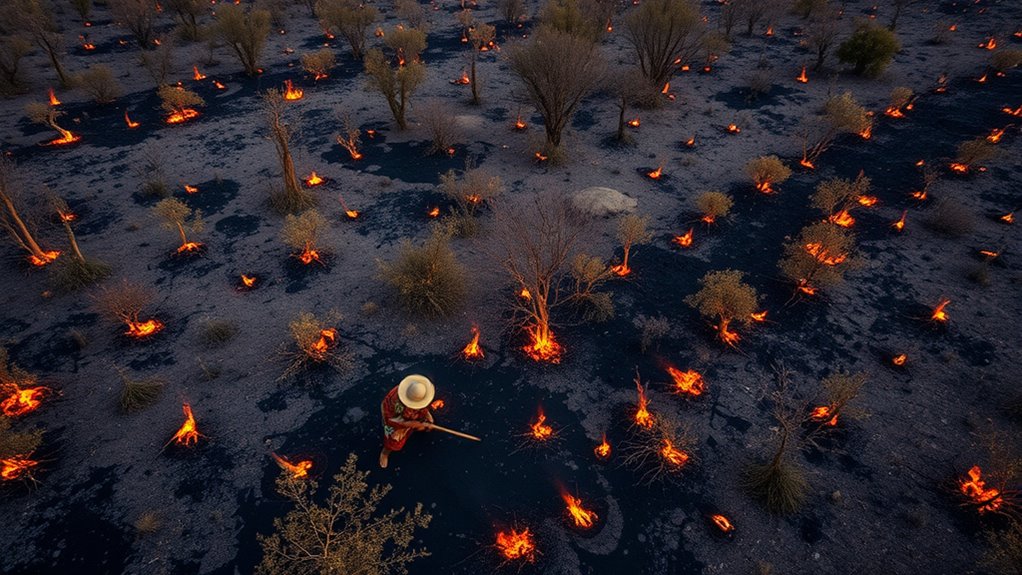
Traditional fire-stick farming is a land management practice practiced by Indigenous communities that involves carefully controlled burns to clear vegetation and promote healthy ecosystems. This technique relies heavily on Indigenous ecological knowledge, which has been passed down through generations. You might not realize it, but this knowledge encompasses an intricate understanding of local plant species, animal behaviors, weather patterns, and the timing necessary for effective burning. Indigenous communities use this wisdom to determine when and where to set fires, ensuring they achieve their ecological and cultural objectives without causing unintended damage.
By applying this traditional approach, Indigenous peoples help maintain diverse and resilient landscapes. Controlled burns reduce excess vegetation, which minimizes the risk of larger, uncontrollable wildfires. They also encourage the growth of nutrient-rich new plants, supporting wildlife and traditional food sources. This practice effectively mimics natural fire regimes, fostering ecosystems that depend on periodic burning for regeneration. It’s a sophisticated system rooted in centuries of experience, where every burn is planned with a clear understanding of ecological outcomes.
Indigenous fire practices maintain ecosystems, prevent wildfires, and support biodiversity through centuries-old land management wisdom.
However, modern fire management policies often overlook or undervalue Indigenous ecological knowledge. Instead, many policies favor suppression strategies aimed at eliminating all fires, regardless of their ecological role. This disconnect can lead to unintended consequences, such as the accumulation of combustible materials and the loss of biodiversity. Recognizing the value of traditional fire-stick farming could reshape fire management policies to be more inclusive and ecologically sound. Incorporating Indigenous perspectives allows for a more nuanced approach, balancing safety with ecological health.
You should see that respecting Indigenous ecological knowledge isn’t just about cultural recognition—it’s about practical fire management. When policies integrate traditional burning practices, they often become more effective at reducing wildfire risk and supporting biodiversity. Indigenous communities are increasingly advocating for their right to practice fire-stick farming, emphasizing that their methods have sustained ecosystems for generations. This shift can lead to collaborative management strategies where Indigenous fire practitioners work alongside land agencies, blending traditional wisdom with scientific research.
In essence, traditional fire-stick farming exemplifies how Indigenous ecological knowledge can inform better fire management policies. It underscores the importance of respecting cultural practices that have long served ecological functions. By doing so, you help foster a more sustainable relationship with the land—one built on respect, knowledge, and shared responsibility. Embracing this approach not only supports healthier ecosystems but also recognizes the vital role Indigenous communities play in managing and caring for the environment.
Frequently Asked Questions
How Do Fire-Stick Practices Vary Among Different Indigenous Groups?
You’ll find fire-stick practices vary among indigenous groups, reflecting their unique cultural significance and environmental needs. Some use controlled burns to promote new growth, while others focus on specific plant management. Knowledge transfer plays a key role, as elders pass down techniques tailored to their land and traditions. These diverse practices help maintain ecosystems, showing how each group adapts fire management to sustain their cultural and natural landscapes.
What Environmental Impacts Result From Fire-Stick Farming?
You might think fire-stick farming harms the environment, but it actually promotes ecosystem recovery and biodiversity enhancement. Controlled fires clear out old vegetation, making space for new growth, which benefits plant and animal diversity. These practices prevent larger, uncontrollable wildfires, maintaining ecological balance. By carefully managing fire, indigenous groups help sustain healthy landscapes, supporting resilient ecosystems that thrive over time.
Are There Modern Restrictions on Traditional Burning Practices?
You might find that legal regulations now restrict traditional burning practices to prevent wildfires and protect ecosystems, but these rules can sometimes challenge cultural preservation. While some regions allow controlled burns for cultural reasons, others impose bans or strict guidelines. It’s important to balance environmental safety with respect for indigenous traditions, encouraging collaboration between communities and authorities to preserve these valuable practices while ensuring safety and ecological health.
How Do Communities Ensure Safety During Controlled Burns?
You guarantee safety during controlled burns by engaging in thorough community training that’s as detailed as a master class. You plan meticulously, using risk mitigation strategies that cover every angle, like a fortress protecting its treasure. You also coordinate with local authorities and weather experts, turning potential chaos into a well-choreographed dance. This proactive approach keeps everyone safe, minimizes risks, and ensures the land’s health is preserved for generations.
What Is the Historical Origin of Fire-Stick Farming Methods?
You should know that fire-stick farming methods originate from Indigenous Australians who developed these practices thousands of years ago. Their cultural significance is profound, as it connects them to land and tradition. These methods also provide ecological benefits, such as promoting biodiversity and reducing larger wildfires. By understanding their history, you can appreciate how these practices sustainably manage land while honoring cultural heritage.
Conclusion
By embracing traditional fire-stick farming, you’re not just managing land—you’re dancing with ancient rhythms written in the earth’s very heartbeat. These practices stitch together ecosystems like a delicate tapestry, where every spark kindles life and renewal. When you honor this wisdom, you’re nurturing a vibrant future rooted in the earth’s own stories. Remember, by keeping these flames alive, you’re tending a sacred garden that blooms with resilience, history, and hope for generations to come.
